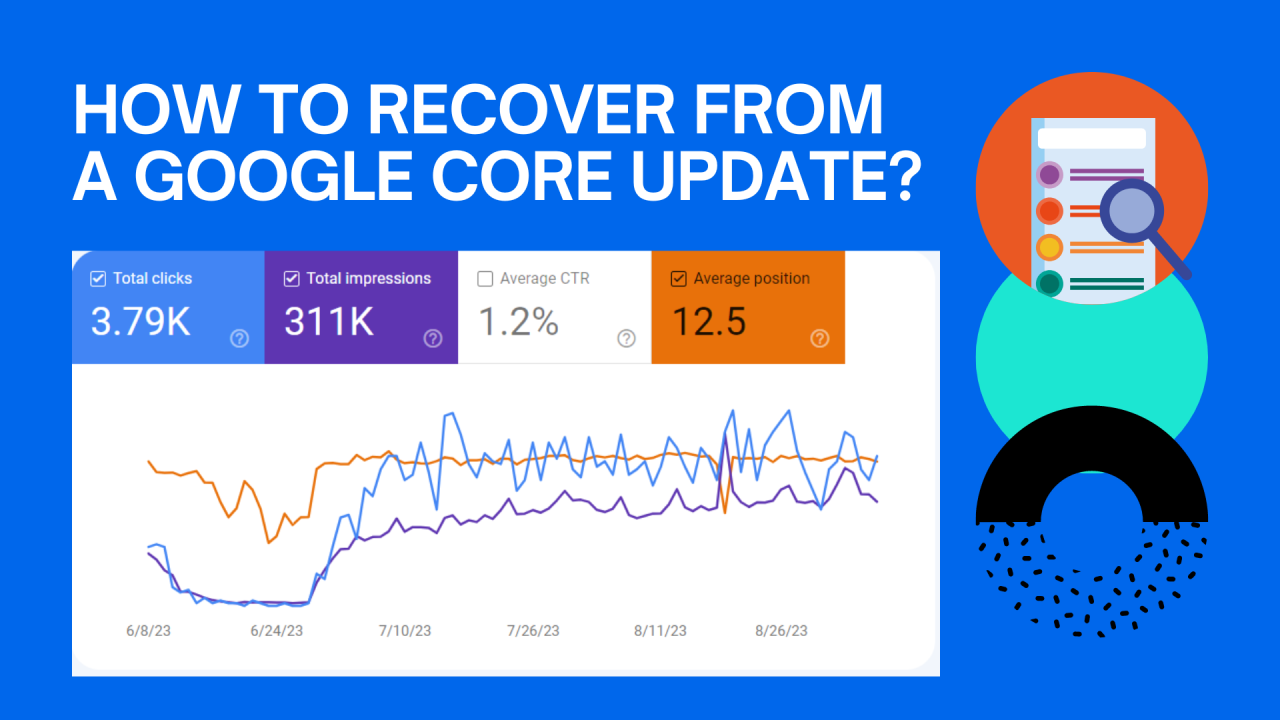How to Recover Website Traffic from Google Core Update?
Regaining website traffic after a Google core update involves analysis, content improvement, and strategic adjustments. Here's a roadmap:
-
Analyse the Impact:
-
Track Changes: Look for dips in traffic, rankings, and specific keywords affected using analytics tools like Google Search Console.
-
Identify Patterns: See if specific content types or sections suffered the most. This might point to relevance issues.
-
Understand Google's Goals:
-
Core Updates Focus: Generally, core updates target improvements in user experience, content quality, and overall site legitimacy.
-
Improve Content Quality:
-
Relevance is Key: Ensure your content directly addresses user search intent and comprehensively tackles the topic.
-
Enhance Expertise: Add value by incorporating insights from credible sources and demonstrating a strong understanding of the subject.
-
Competitor Analysis: See how top-ranking sites are approaching the content and identify areas where you can improve.
-
Authority and Backlinks:
-
Build Backlinks: High-quality backlinks from relevant websites signal trustworthiness to Google.
-
Brand Mentions: Encourage mentions of your brand and content on reputable sites.
-
Technical SEO:
-
Double-check: Ensure your website has a clean technical foundation with good loading speed, mobile-friendliness, and proper indexing.
-
Content Strategy:
-
Fresh Content: Consider publishing new, high-quality content that aligns with user needs and addresses current trends.
Remember: There's no quick fix. Focus on creating an exceptional user experience with valuable, well-researched content. Patience and persistence are key to regaining traffic after a core update.
How to recover from Google March 2024 core update?
The recovery process for the March 2024 core update is similar to recovering from any core update. Here's a breakdown of the steps:
Identify Affected Areas:
-
Search Console: Use Google Search Console to pinpoint pages that experienced ranking or traffic loss.
-
Analytics Dive: Analyze traffic data to see which keywords and content types were hit the hardest.
Focus on Content Quality:
-
Improve Existing Content: Review and enhance existing content to ensure it's relevant, informative, and addresses user search intent in a comprehensive way.
-
E-A-T Optimization: Optimize content according to Google's E-A-T (Expertise, Authoritativeness, and Trustworthiness) principles. Use credible sources, showcase expertise, and establish yourself as a trustworthy authority on the topic.
-
Content Audit: Consider a content audit to identify and remove thin, outdated, or irrelevant content.
Technical SEO Check
-
Technical Health: Make sure your website has a solid technical foundation with good loading speed, mobile-friendliness, and proper indexing.
Backlinks Matter
-
Backlink Profile Review: Analyze your backlink profile and remove low-quality or spammy backlinks.
-
Build High-Quality Backlinks: Focus on acquiring backlinks from relevant, high-authority websites.
Stay Updated:
-
Keep an Eye on Google Updates: Follow SEO news and Google announcements to stay updated on future algorithm changes.
Be Patient:
-
Recovery Takes Time: Regaining traffic after a core update is a gradual process. Focus on creating high-quality content and providing exceptional user experience.
Remember, there's no magic bullet. By implementing these steps and prioritizing user value, you can increase your chances of recovering from the March 2024 core update.
How to survive Google Core Update in the Future?
There's no guaranteed way to completely shield yourself from future Google core updates, but by focusing on user-centric SEO practices, you can significantly improve your website's resilience. Here are some key strategies:
-
Prioritize User Experience: Google prioritizes user experience. Ensure your website has a clean interface, fast loading speed, and mobile-friendliness. Tools like Google's PageSpeed Insights can help you identify areas for improvement.
-
Content is King (and Queen): Focus on creating high-quality, informative content that solves user problems and comprehensively addresses search intent. Regularly update content to ensure it stays fresh and relevant.
-
Expertise, Authoritativeness, Trustworthiness (E-A-T): Strive to establish your website and yourself as an authority in your niche. Cite credible sources, showcase your expertise, and build trust with your audience.
-
Diversify Your Traffic Sources: Don't rely solely on organic search for website traffic. Explore social media marketing, email marketing, and other channels to build a broader audience base.
-
Stay Informed: Keep yourself updated on SEO best practices and potential algorithm changes by following SEO news and Google announcements.
Here are some additional tips:
-
Monitor Your Analytics: Regularly monitor your website traffic and rankings using tools like Google Search Console and Google Analytics. This will help you identify any potential issues early on.
-
Focus on Long-Term Strategy: Don't chase quick SEO wins. Build a sustainable SEO strategy that focuses on creating valuable content and providing a great user experience.
-
Avoid Blackhat Techniques: Google penalizes websites that use blackhat SEO tactics like keyword stuffing or link buying. Focus on white-hat SEO practices that prioritize user value.
By following these strategies, you can create a website that is well-positioned to weather future Google core updates. Remember, the goal is to create a website that users love and trust, which naturally aligns with Google's goals for search results.



